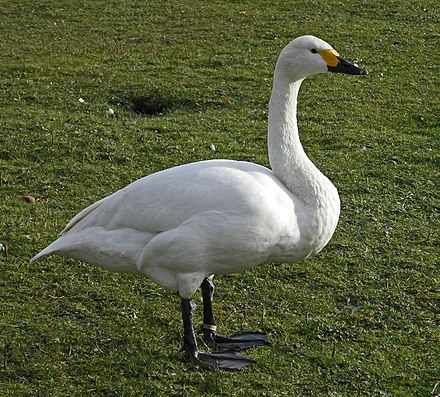Swans are elegant waterfowl that are often considered the iconic species of lakes and bodies of water. The following is detailed information about swans and their living habits:

Size: Swans are larger waterfowl with long necks and strong bodies. Their weight can vary from 11 to 15 kilograms as an adult, and occasionally even more.
Feathers: Swans are often named for their white feathers, which are their distinguishing feature. Feathers are extremely soft and provide the insulation they need to swim in water and survive in cold environments.
Beak and Feet: Swans have orange or black beaks and pink paws, which contrast with their pure white feathers.
Geographic distribution: Swans are distributed around the world, with some species primarily inhabiting the Northern Hemisphere, such as mute swans, while other species are primarily found in the Southern Hemisphere, such as black swans and several South American swan species.
Habitat: Swans generally choose to live in watery environments such as lakes, rivers, marshes and coastal wetlands, which provide ample food resources and habitat.
Food habits: Swans are omnivores and feed mainly on aquatic plants, aquatic plants, algae and some small aquatic organisms. They usually search for food by diving or directly in the water.
Migration: Some swan species undergo seasonal migrations in search of more suitable habitat and climate conditions. Migration usually occurs during the colder seasons.
Living in groups: Swans are social birds that often form groups and form complex social structures in groups. They also live in family units.
Reproduction: Swans usually have a high breeding rhythm and will look for suitable environments for nesting and incubation during specific breeding seasons.
Protective Behavior: Swans often have a strong protective instinct for their territory and offspring, and some species take very good care of their offspring during or after hatching.
The family Cygnus includes several different species, mainly mute swans, chameleon geese, black swans, cygnets, etc.
Swans have attracted much attention due to their beautiful appearance and important ecological role. In some areas, protection of swans and their habitats is integrated into local reserves and conservation plans.
Swans are popular for their noble and elegant image and diverse living habits. Through an in-depth understanding of the ecological habits and conservation status of swans, we can better protect these beautiful animals and their habitats and maintain ecological balance.
animal tags: swan
We created this article in conjunction with AI technology, then made sure it was fact-checked and edited by a Animals Top editor.